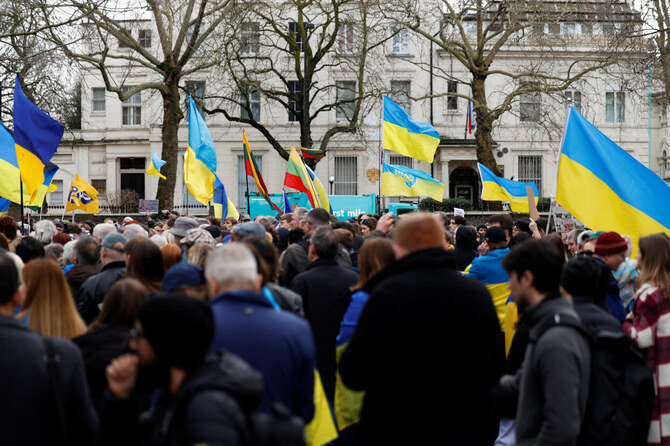LONDON: Hundreds gathered in London on Saturday to march in support of Ukraine, ahead of the third anniversary of Russia’s invasion on Monday and amid increasing tensions between Washington and Kyiv.
Protesters started at a statue of St. Volodymyr, a national saint of Ukraine, in west London and marched toward the Russian embassy, waving Ukrainian flags and signs of support.
The three-year long war was sparked by the Russian invasion of Ukraine on February 24, 2022.
Britain has been a key backer of Ukraine since, sanctioning Moscow, providing financial and military support to Kyiv and opening its door to over 250,000 Ukrainian refugees.
At the rally, one sign read “Ukraine defends peace for the entire Europe,” while another said “If Ukraine falls, war will come to your house.”
“I’m not Ukrainian but I recognize the great danger they are in,” 68-year-old Briton Martin Vincent told AFP.
“We cannot abandon them it’s a duty for the UK to stand up with Ukraine,” the protester added.
Among the crowd were some Ukrainians, including Nataliya, a university student who did not want to share her last name for security reasons.
“I feel so homesick and so vulnerable right now. I don’t know If I’ll be able to come back to my country,” said Nataliya, wearing a floral crown in the yellow and blue of the Ukrainian flag.
“What’s next? Uncertainty and uncertainty,” she added.
Stella Robinson, 27, was “afraid of what might happen next” as well. “This is not only Ukraine, this is Europe.”
“We can’t turn a blind eye on the war just because Trump wants peace,” added Robinson, referring to recent diplomatic talks between the US and Russia on the future of the war that have sidelined Kyiv and its European backers.
“But what kind of a peace? Frankly, it’s terrifying,” added the law student.
British public support for Ukraine is strong, with 67 percent saying they both want Ukraine to win the war and care a “great deal or fair amount” that it does so, according to a YouGov poll from last week.
And eight in ten Britons said it is “unacceptable” for Ukraine not to be included in negotiations on the conflict, per the poll.
Thousands of Ukrainian civilians have been killed since the start of the war, although the exact toll is unclear.
Londoners march in support of Ukraine to mark three years of war
https://arab.news/5r88r
Londoners march in support of Ukraine to mark three years of war

- Protesters started at a statue of St. Volodymyr in west London and marched toward the Russian embassy, waving Ukrainian flags and signs of support
- At the rally, one sign read “Ukraine defends peace for the entire Europe“
Bolivia and Israel to restore ties severed over the war in Gaza

- Paz's government eased visa restrictions on American and Israeli travelers last month
- The Bolivian foreign ministry said its top diplomat would meet his Israeli counterpart in Washington later Tuesday to discuss the revival of bilateral ties
LA PAZ, Bolivia: Bolivia's new right-wing government said Tuesday that it would restore diplomatic relations with Israel, the latest sign of the dramatic geopolitical realignment underway in the South American country that was once among the most vocal critics of Israeli policies toward Palestinians.
The Bolivian foreign ministry said its top diplomat would meet his Israeli counterpart in Washington later Tuesday to discuss the revival of bilateral ties, which Bolivia's previous left-wing government severed two years ago over Israel's devastating campaign against Hamas in Gaza.
Bolivia said the effort came as part of a new foreign policy strategy under conservative President Rodrigo Paz aimed at “rebuilding Bolivia's international prestige, opening new economic opportunities and strengthening alliances that directly benefit the country and our citizens abroad."
Bolivian Foreign Minister Fernando Aramayo is in the midst of a whirlwind trip to Washington for meetings with American officials as his government works to warm long-chilly relations with the United States and unravel nearly two decades of hard-line, anti-Western policies under the Movement Toward Socialism, or MAS, party that left Bolivia economically isolated and diplomatically allied with China, Russia and Venezuela.
Paz's government eased visa restrictions on American and Israeli travelers last month.
In announcing his expected meeting with Aramayo on Monday, Israeli Foreign Minister Gideon Saar thanked Bolivia for scrapping Israeli visa controls and said he spoke to Paz after the center-right senator's Oct. 19 election victory to express “Israel’s desire to open a new chapter” in relations with Bolivia.
Paz entered office last month, ending the dominance of the MAS party founded by Evo Morales, the charismatic former coca-growing union leader who became Bolivia's first Indigenous president in 2006. Not long after taking power, Morales sent Israel's ambassador packing and cozied up to Iran over their shared enmity toward the U.S. and Israel.
When protests over Morales' disputed 2019 reelection prompted him to resign under pressure from the military, a right-wing interim government took over and restored full diplomatic relations with the U.S. and Israel as it sought to undo many of Morales’ popular policies.
But 2020 elections brought the MAS party back to power with the presidency of Luis Arce, who in 2023 once again cut ties with Israel in protest over its military actions in Gaza.
Other left-wing Latin American countries, like Chile and Colombia, soon made similar moves, recalling their ambassadors and joining South Africa’s genocide case against Israel before the United Nations’ highest judicial body.














